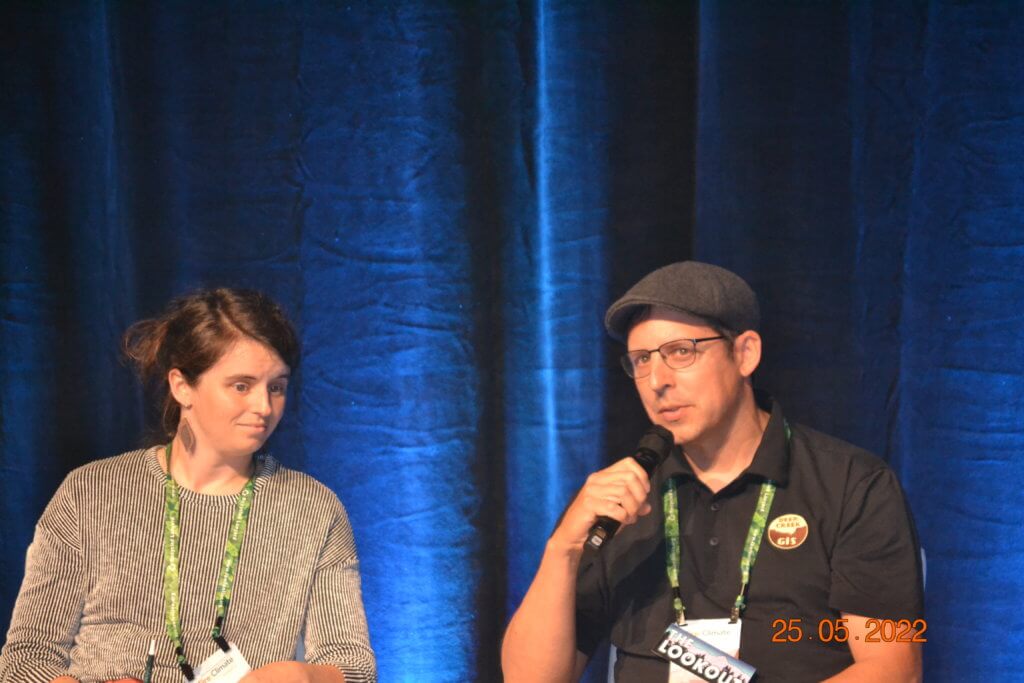FIRE & CLIMATE 2022
CHANGING THE NARRATIVE
MEDIA PANEL RECOMMENDS FOCUS ON POSITIVE NEWS
BY DYLAN BRUCE

Readers and viewers have grown weary of doom-and-gloom wildfire stories and crave news about how they can help change policy, according to members of the communications and media panel at Fire & Climate 2022 in Pasadena.
Reporters, podcasters and public-information officers who comprised the five-person panel said their audiences want a more complete picture of the wildfire problems so they can take action.
“People want to know how they can help on an individual level and on a community level, so it’s about providing the tools and resources for that,” said Amanda Monthei, creator and host of the Life with Fire podcast.
Other panelists were Nathan Rott from NPR, Elizabeth Weil from New York Magazine, filmmaker Trip Jennings, Zeke Lunder, host of The Lookout, a wildfire education channel, and Kristin Alison, a fire management officer and public information officer for the U.S. Forest Service – Type One Incident Management Team in California.
Panellists opened with a discussion about their different timeframes and deadlines and noted that deadlines affect the depth of coverage.
For example, Rott, who has covered many wildfires, said he has tight deadlines.
“I’m one of those people that has to parachute into places,” he said. “And I know that there’s a lot of consternation over parachute journalism for very good reason. I basically have to show up and do a really quick-turn piece.”
In stark comparison, Weil said she can have months to put together a piece for New York Magazine. The longer time frame allows her to build characters and narratives and develop relationships with members of the wildland fire community.
“I’m a generalist,” Weil said. “I covered climate for a few years, but I’m really an outsider, so building relationships, getting to know people, having people themselves be really emotionally honest and willing to share complicated stories is what makes my job possible.”
Speaking about the yearning for positive news stories, Monthei said she tries to highlight wildland fire professionals who are doing meaningful work to make a difference. Podcast listeners, Monthei said, want to know how they can do the same.
Jennings, the filmmaker, echoed Monthei’s sentiments, and explained that his team puts a lot of thought into titles and thumbnails when posting content to YouTube, and have found that the traditional narrative of a battle against wildfire isn’t effective.
“The military framing around it does not work for us,” Jennings said. “Climate does. Solutions-oriented stuff does.”
The ever-changing demands of reporting on wildfire demands innovation to overcome old and new obstacles, the panelists said, and they had differing accounts of how they have adapted.
Rott highlighted the increasing importance of social media in reporting. Speaking from Ukraine, he explained how social media is a vital source of information from officials and the public, but that it isn’t without its drawbacks.
“In a way, that democratization of information is really powerful and good, but I also think that it cuts both ways,” Rott said. “It’s a real challenge when there’s so many people trying to communicate their stories and content. It’s a diluted space.”
Highlighting this desire for more access, Lunder explained how he often struggles to get up-to-date infrared imagery. He said during the Dixie fire in Northern California in 2021 there were regular flights capturing images of the fire from above, but it took hours for the footage to be released to media and the public.
“That’s frustrating, because I feel like that’s critical information, and the wider we spread it the better. I’ve got firefighters watching my site and they can get it easier from me than they can get it from the actual incident.”
Alison said social media has distorted public expectations of content – everyone wants Instagram-worthy images and footage, and there is a lack of understanding of the tough conditions under which reporters work.
“In this day of influencers and social media stars, everyone thinks you’re going to have full production capacity. We get comments like ‘Why is their lighting so bad?’ or ‘Why did their bandwidth drop?’”
Alison also touched on how laws and regulations can hamper her team’s efforts to communicate with the media.
“It may look like we’re withholding or not providing all the information, but it’s just the process,” she said.
The session ended with a discussion about good fire and bad fire, and the difficulty communicating these concepts to audiences who are largely uninformed about wildfire policy and management history. Timing, Monthei said, is critical to help readers and viewers understand the broader wildfire world. For example, during wildfire season, audiences are focused on incidents and safety, and are more open to policy stories in the winter when their homes and personal safety are not threatened.
“I don’t think that August is the time to be pushing the narrative of ‘good fire’, as there’s very much the reality of fire as a disaster,” she said.
“For me it’s a matter of timescales and reading the room, and understanding what people are interested in hearing about at the exact moment you are coordinating that messaging.”
Speaking about the Dixie fire, Lunder noted that a fire had burned through the same area 10 years ago and the resulting fuels reduction bought time that allowed firefighters to save multiple towns. Highlighting such tangible examples of how fire can be beneficial is a good way to start to change people’s understanding of wildfire, Lunder said.
“I think we can call on history and spin a larger story that has space for (good fire and bad fire).”
